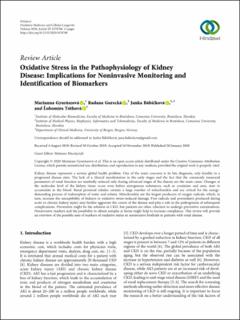| dc.contributor.author | Gyurászová, Marianna | |
| dc.contributor.author | Gurecká, Radana | |
| dc.contributor.author | Babickova, Janka | |
| dc.contributor.author | Tóthová, Ľubomíra | |
| dc.date.accessioned | 2021-04-12T09:30:16Z | |
| dc.date.available | 2021-04-12T09:30:16Z | |
| dc.date.created | 2020-04-20T13:20:44Z | |
| dc.date.issued | 2020 | |
| dc.Published | Oxidative Medicine and Cellular Longevity. 2020, 2020:5478708 1-11. | |
| dc.identifier.issn | 1942-0900 | |
| dc.identifier.uri | https://hdl.handle.net/11250/2737258 | |
| dc.description.abstract | Kidney disease represents a serious global health problem. One of the main concerns is its late diagnosis, only feasible in a progressed disease state. The lack of a clinical manifestation in the early stages and the fact that the commonly measured parameters of renal function are markedly reduced only during advanced stages of the disease are the main cause. Changes at the molecular level of the kidney tissue occur even before nitrogenous substances, such as creatinine and urea, start to accumulate in the blood. Renal proximal tubules contain a large number of mitochondria and are critical for the energy-demanding process of reabsorption of water and solutes. Mitochondria are the largest producers of oxygen radicals, which, in turn, increase the susceptibility of kidneys to oxidative stress-induced damage. Free radicals and prooxidants produced during acute or chronic kidney injury may further aggravate the course of the disease and play a role in the pathogenesis of subsequent complications. Prevention might be the solution in CKD, but patients are often reluctant to undergo preventive examinations. Noninvasive markers and the possibility to obtain samples at home might help to increase compliance. This review will provide an overview of the possible uses of markers of oxidative status in noninvasive biofluids in patients with renal disease. | en_US |
| dc.language.iso | eng | en_US |
| dc.publisher | Hindawi | en_US |
| dc.rights | Navngivelse 4.0 Internasjonal | * |
| dc.rights.uri | http://creativecommons.org/licenses/by/4.0/deed.no | * |
| dc.title | Oxidative Stress in the Pathophysiology of Kidney Disease: Implications for Noninvasive Monitoring and Identification of Biomarkers | en_US |
| dc.type | Journal article | en_US |
| dc.type | Peer reviewed | en_US |
| dc.description.version | publishedVersion | en_US |
| dc.rights.holder | Copyright 2020 Marianna Gyurászová et al. | en_US |
| dc.source.articlenumber | 5478708 | en_US |
| cristin.ispublished | true | |
| cristin.fulltext | original | |
| cristin.qualitycode | 1 | |
| dc.identifier.doi | 10.1155/2020/5478708 | |
| dc.identifier.cristin | 1807130 | |
| dc.source.journal | Oxidative Medicine and Cellular Longevity | en_US |
| dc.source.40 | 2020:5478708 | |
| dc.identifier.citation | Oxidative Medicine and Cellular Longevity. 2020, 5478708. | en_US |

